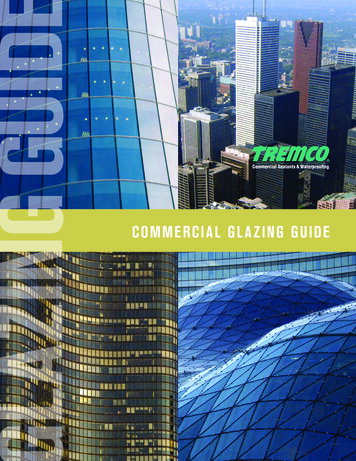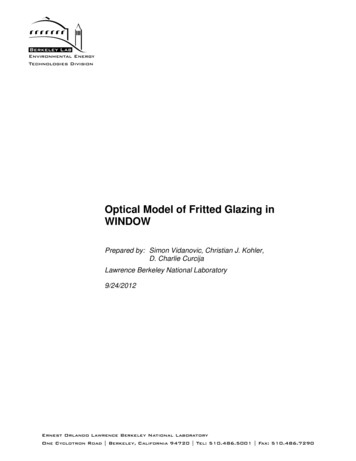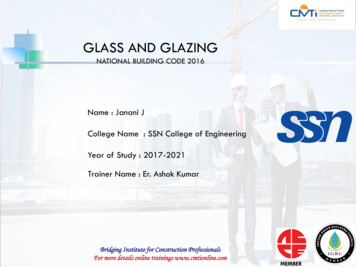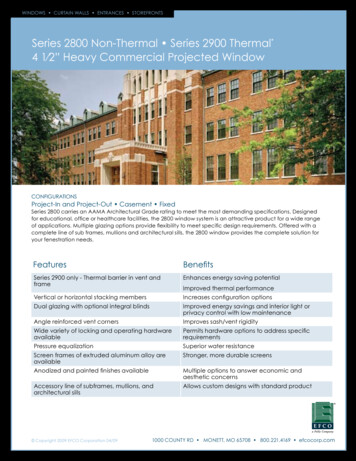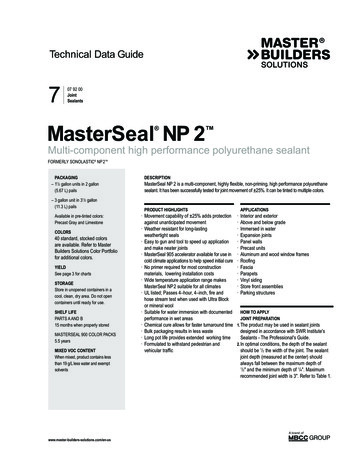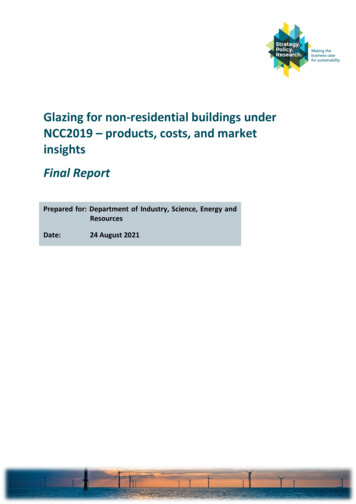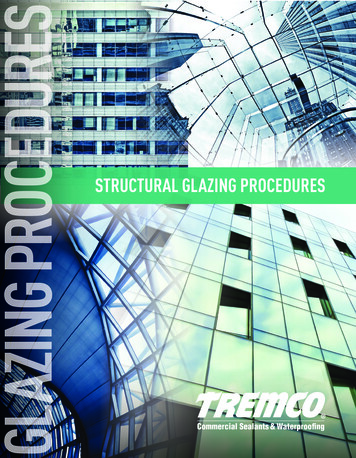
Transcription
GLAZING PROCEDURESTREMCO STRUCTURAL GLAZING PROCEDURESSTRUCTURAL GLAZING PROCEDURES1
TABLE OF CONTENTS PAGEI. PROJECT CHECKLIST 4II. INTRODUCTION 5A. Required information 5B. Reporting 6C. Pump maintenance 6III. TREMCO CONTACT INFORMATION7IV. GUIDE FOR WORKMANSHIP 8A. Surface Preparation 8B. Framing 8C. Setting blocks 8D. Structural spacers 8E. Detail drawings 9F. Pre-installation meeting 9G. Adhesion testing 9V. GUIDE FOR SEALANT APPLICATION 10A. Cleaning 10B. Priming 11C. Masking 11D. Sealant application 12VI. GUIDE FOR ADHESION CHECK 13A. Tab adhesion test method 13B. Hand pull adhesion test method14C. Repair of sealant in adhesion test area14VII. ONE-PART SILICONE SEALANT – QUALITY ASSURANCE PROGRAM15A. Test #1 – Tack Free Time15B. Test #2 – Through Cure Test16C. One-Part Quality Check – Logbook 17VIII. TWO-PART SILICONE SEALANT – QUALITY ASSURANCE PROGRAM18A. Overview 18B. Test #1 – Butterfly Test 19C. Test #2 – Snap Time Test20D. Test #3 – Color Check 21E. Test #4 – Snake Test 21F. Test #5 – Adhesion Test 22G. Test #6 – Flow Rate Check 22H. Test #7 – Shore “A” Test24I. On Ratio Verification Techniques 25
TABLE OF CONTENTS CONT’DPAGEIX. GUIDE FOR REGLAZING 26A. Glass failures 27B. Sealant failures 27X. APPENDIX 28A. Structural Glazing Testing Initiation Form28B. Deglaze Test Log 29C. Technical Service Bulletin No. S-08-4730
I. PROJECT CHECKLISTThe list of items below must be completed for a SILICONE STRUCTURAL GLAZING PROJECT to becompliant with best practices and to be eligible for a Tremco Structural Glazing Warranty. As eachitem is completed, record the date in the appropriate space. For items that are not applicable on aproject, please mark “NA” (not applicable).DESIGN DETAILSDate CompletedCUSTOMER submits shop and elevation drawings to TREMCO.CUSTOMER submits maximum positive and negative wind load force values for theproject to TREMCO.CUSTOMER submits metal finish/paint code for the project to TREMCO.TREMCO provides project specific shop drawing review letter.ADHESION AND COMPATIBILITY TESTING[AND NON-STAIN TESTING IF REQUIRED]Date CompletedCUSTOMER provides TREMCO with representative sample of project-specific metal(including finish).CUSTOMER provides TREMCO with representative sample of project-specific glass.CUSTOMER provides TREMCO with representative sample of project-specificaccessories, including setting blocks, spacers and gaskets.CUSTOMER provides TREMCO with representative sample of project-specific poroussubstrates for sealant stain testing when required.TREMCO provides lab report including test date(s).QUALITY ASSURANCECUSTOMER completes and documents daily QC tests as outlined in this manual.TREMCO STRUCTURAL GLAZING PROCEDURESCUSTOMER deglazes shop units to verify adhesion and documents on log sheets.CUSTOMER provides TREMCO with documentation of QC tests performed (as notedabove).4
II. INTRODUCTIONTremco, as a recognized supplier of structural silicone sealants and compatible glazing materials,understands the high performance requirements and potential liabilities inherent to structurallyglazed walls. For these reasons, Tremco offers preconstruction project reviews and testingprograms to ensure product performance characteristics and glazing integrity. This program,founded in industry practice and specifications, is offered to our clients at no additional chargeand demonstrates Tremco’s commitment to quality and attainment of the highest standards.Each structurally glazed project in which Tremco is involved is reviewed and tested in accordancewith the parameters of this in-house program. Pertinent recommendations and results are sharedwith the customer with the assistance of Tremco. Each member of this team has a keen sense ofcommitment to the success of each project.A. REQUIRED INFORMATIONFollowing is an overview of the minimum information required by Tremco prior to the beginning ofeach structural glazing project.General information on the project such as: Project title, size and location Architect and consultant involved in the project Fabricator Glazing and caulking subcontractors Glazing start and completion datesTREMCO STRUCTURAL GLAZING PROCEDURESReview of the structural glazing details to identify: Proper use of Tremco glazing materials including sealants, gaskets, tapes and setting blocks. roper tensile bead location. Structural tensile beads are normally located on the interior facePof the lite or panel (#2 or #4 surface) with bonding to a structurally sound substrate such as ahorizontal or vertical aluminum mullion with a specified architectural finish. Confirmation of glass supplier and types (e.g., monolithic, I.G. unit, laminated) and identificationand description of coatings (e.g., reflective or opacifier) with their respective sizes approved forstructural glazing. Confirmation of coating/anodizing company, identification of coating (type, name, code and batchnumber) and location of metal and substrate finishes. Mill finished substrates are not acceptablefor structural glazing applications. Verification of proper sealant selection and usage.5
Project specification review to identify: Design windload force requirements for the project (positive and negative windload force). roper tensile bead sizing: the sealant bite or sealant contact depth (SCD) is calculated from thePdesign wind load and glass dimensions. Based on these calculations, Tremco recommends aminimum tensile bead size of 1/4" x 1/4" (6 mm x 6 mm). Tensile beads (sealant bite) exceeding1/2" (13 mm) warrant special consideration as sealant curing characteristics may be affected.Please consult your Tremco Technical Sales Representative for special guidelines, or contact us byclicking “Ask the Expert” under the Technical Resources Tab on the Tremco websitewww.tremcosealants.com. I dentify the type of structural glazing application (2-sided, 4-sided, sloped), on-site or in-plantapplication, vision and/or spandrel application. Testing designated and required beyond that typically done. Information and/or performance requirements specific to the project.Substrate requirement for adhesion testing: Substrates typically tested in order to determine proper cleaning techniques and primingrequirements include aluminum framing and glass or other glazing panels. Substrates should be submitted to Tremco Technical Services Department and be representativeof those to be used on the actual project (production run sample). See Technical Service BulletinNo. S-08-47 (Lab Testing Requirements) in Appendix. Adhesion testing is performed according to Tremco and/or ASTM C794 methods. Results oftesting are normally available 4 to 6 weeks after receipt of the substrates.Identification of substrate in contact with the silicone structural glazing sealant: Tremco will verify that all the elements installed within the glazing pocket are compatible when incontact with the silicone sealant (tensile bead) and will not affect its in-place performance. Compatibility testing can be run according to Tremco Modified ASTM C1087. See TechnicalServices Bulletin No. S-08-47 (Lab Testing Requirements) in Appendix. The test will determinecolor change or adhesion loss as a result of sealant contact or proximity of incompatiblematerials. Substrates to be tested include, but may not be limited to, setting blocks, structural spacer(tapes or gaskets), compression gaskets, insulating glass edge seals, glass laminates, backer rod,weatherseal, and thermal break.B. REPORTING:TREMCO STRUCTURAL GLAZING PROCEDURESUpon completion of the drawing and specification review and adhesion and compatibility testing,a formal report is issued which details recommendations and test results specific to the successof the individual project. These results and recommendations are intended to serve as a baseof information which should be confirmed on actual project applications at ongoing intervals asdescribed in the following structural glazing procedures. This promotes consistent performanceand quality and confirms laboratory results.Tremco Technical Services will issue a report(s) for the structural glazing application after allevaluation and testing for the specific project are completed Any work done beyond this point bythe contractor without the letter of approval becomes the contractor’s sole responsibility.C. PUMP MAINTENANCERefer to your pump manufacturer’s guidelines for specific instructions.6
III. TREMCO CONTACT INFORMATIONTechnical Services:866.209.2404Customer Service:United States:Canada:800.321.7906800.363.3213Extruded Rubber Customer Service:800.321.6357Tremco CS&W Website:www.tremcosealants.comTREMCO STRUCTURAL GLAZING PROCEDURESYour local Tremco Sales Representative: Use the Rep Locator on our websiteto find a sales representative near aspx7
IV.GUIDE FOR WORKMANSHIPA. SURFACE PREPARATIONAll components receiving the structural glazing silicone sealant (i.e., aluminum and glass) shall bethoroughly wiped with a clean lint-free cloth dampened with a recommended cleaner, as approvedby Tremco and immediately followed by a dry wipe (2-rag method). Use a clean cloth for the drywipe. Special precautions must be taken in cold weather to ensure surfaces are free from frostand/or condensation. For factory glazing, both the glass and framing should be stored indoors in acontrolled environment for 24 hours prior to glazing. This will prevent the formation of frost and/orcondensation that may occur if cold materials are brought into a warm area.All surfaces once cleaned and/or primed should be handled carefully so as not to contaminate thesurfaces.B. FRAMINGAll framing shall be checked prior to glazing to make certain that the opening is square, plumb,and secure in order that uniform sealant bite, face and edge clearances are maintained. Inspectall butt and miter joints. If these joints are open, they shall be sealed prior to glazing using asealant confirmed to be compatible with the structural silicone sealant. Maintain minimum edgeclearances between glass and sash, as outlined by the glass manufacturer, and sealant contactdepth (sealant bite) as recommended by Tremco for this specific project.C. SETTING BLOCKSSetting blocks shall be used, as required, to support the glass/I.G. unit in structural glazingapplications. The use of setting blocks will prevent the addition of stress applied on the structuraltensile bead due to the dead load of the glass/I.G. unit. Setting blocks should be of a 80 /- 5 ShoreA Durometer hardness in order to support the dead load of the glass/I.G. unit.Locate setting blocks on the sill member as recommended by the glass manufacturer. Whenthe sill section is structurally glazed (for both 2-sided and 4-sided systems), setting blocks shallbe recessed to allow for adequate sealant contact (weatherseal) and glass support. When usinginsulating glass in a structural glazing application, the industry generally agrees that setting blocksshould be recessed 50% of the thickness of the outboard lite of glass. The I.G. unit sealant supplierin conjunction with the structural sealant supplier shall confirm the polymer type of setting blocksthat are compatible and can be used in the structural glazing application.D. STRUCTURAL SPACERSTREMCO STRUCTURAL GLAZING PROCEDURESStructural spacers used in this application must be compatible with the structural silicone sealantand positioned on the frame to ensure correct sealant contact depth as recommended andspecified by Tremco. The silicone compatible spacers shall be of the required hardness to maintaina recommended uniform face clearance for all glass sizes.The sealant cavity created by the installation of the structural spacer should be located in planewith the nozzle of the gun allowing direct entry of the sealant into the cavity. Out-of-plane orindirect access of the sealant to the cavity should be avoided.8
E. DETAIL DRAWINGSFull sized details of the structural glazing pocket(s) showing the metal system(s) must be submittedto Tremco for review prior to the beginning of the project. Placement of materials must be shownon the details. If framing from the fabricator differs from the submitted details, the principalparties must resolve differences before proceeding further with the project.F. PRE-INSTALLATION MEETINGAll materials shall be used in accordance with Tremco’s printed instructions. A meeting to reviewprocedures, tests required and sealant application should be held during bid stage and prior tothe beginning of the work on the project. A Tremco representative should be present at the start ofeach job to review procedures and instruct in sealant application.G. ADHESION TESTINGProper adhesion of the sealant to the substrate must be achieved prior to movement of the units tostorage. Proper adhesion is achieved when the adhesion test results in cohesive separation of thesealant.Typically units fabricated with Proglaze II can be moved horizontally within 4 hours as long as theyare blocked and stabilized to ensure that the sealant adhesion is not compromised. These unitscan be moved from a horizontal to a vertical position after adhesion is checked and found to beacceptable.Units can then be moved to the job site after proper sealant adhesion is verified. This is typicallydone within 24 hours after fabrication. Units should be packaged for shipment in a fashion that willprevent additional stress on the sealant substrate bondline.TREMCO STRUCTURAL GLAZING PROCEDURESAdhesion tests must be performed by the contractor at the beginning and during the projectapplication. A logbook recording all tests and verifications must be kept by the contractor as it willbe used for contractor control (refer to Sealant Quality Assurance Programs in Sections VII andVIII of this guide). These documents should be submitted for warranty administration. A warrantycannot be issued without this information.9
V. GUIDE FOR SEALANT APPLICATIONIt is essential that Tremco Structural Glazing Sealants are installed in accordance with Tremco’srecommendations and specific written instructions. Proper surface preparation is extremelyimportant to the longevity and performance of Tremco structural silicone sealants. Substratesamples tested must be actual production run samples and must be representative of thematerials to be used on the job site.A. CLEANING1. I sopropyl alcohol (IPA) is the recommended solvent for cleaning metal and glass intended forstructural glazing applications.2. T he solvent acts as a degreaser to remove the cutting oils and other contaminants used in thefabrication of the framing system. The solvent must be clean and fresh and must comply withlocal occupational safety codes. When used indoors, such as in a factory environment, properventilation must be provided.3. C loths used for cleaning of all framing members should be white, lint free and resistant to therecommended solvent. Do not use chemically treated rags. Do not hesitate to change the clothsfrequently as they will become soiled during the cleaning operation. It is easy to see the soiling ifwhite rags are used.4. P our the approved solvent onto a clean, dry cloth. Do not place cleaning cloth into the solventsolution container. This prevents solvent contamination, which can lead to a sealant adhesionproblem. Vigorously rub the glass and metal surfaces to remove the contaminants. Continuouslyrotate the cloth, lifting off the oils loosened by the solvent.5. D o not allow the solvent to air dry during the cleaning procedure. After the solvent wipe, followimmediately with another clean dry cloth to wipe the surface dry (2-rag method). Allowing thesolvent to dry on the surface without wiping with a second cloth negates the entire cleaningprocedure because the contaminants are redeposited as the solvent dries.6. W hen cleaning deep, narrow joints, wrap the cleaning cloth around a clean, narrow-blade puttyknife. This permits force to be applied to the surface to be cleaned.7. C lean only as much area as can be sealed in 1 hour. If cleaned areas are exposed tocontaminants (oils, dirt, dust, etc.), the surface must be cleaned again.8. K eep solvent containers closed when not in use. Temperature and humidity will affect theevaporation rate of the applied solvent therefore affecting its cleaning power.9. Caution:TREMCO STRUCTURAL GLAZING PROCEDURESa. N ever use a paintbrush for the cleaning procedure. It is not effective in removing thecontaminants off the surface. The rubbing action of the cloth is critical and essential forloosening up the contaminants from the substrate.b. S ome “cutting oils” used in the fabrication process may not be soluble in IPA.This should be verified before commencing the project.c. F or porous substrates, contact Tremco for appropriate cleaning surface preparation.10
B. PRIMING1. P rimer, when properly used, will promote strong and consistent adhesion of the silicone sealantto the substrates to which it may otherwise be difficult to bond. If a primer is required, it will beconfirmed during the adhesion test executed prior to the beginning of the work.2. T remco offers TREMprime Silicone Metal Primer for most metal finishes. This primer is non-filmforming and moisture sensitive. This sensitivity to water may result in cloudiness or developmentof white precipitates (settling) in the container. Should either of these conditions exist, theprimer should be discarded.3. A lways pour TREMprime Silicone Metal Primer onto a clean applicator. Never place theapplicator into the primer container.4. A pply a thin film of TREMprime Silicone Metal Primer using a clean lint-free cloth. DO NOT use abrush for application. Excessive application may result in a white powdery deposit, which mustbe removed before sealant application. This white deposit can be removed with a clean clothdampened with the recommended cleaner. Reapply a fresh, lighter application of primer. A lightapplication on a non-porous surface may best be accomplished by application with a clean, nontreated cloth or tissue dampened with primer.5. C aution: Primers are not to be substituted for good surface preparation. The substrate to receivethe primer shall be thoroughly cleaned using the recommended cleaner, and dried, prior to theinstallation of the primer.6. A llow the primer to dry for a minimum of 15 minutes before sealant application. Protection ofthe primed area from contaminants is essential to ensure proper adhesion. If the primed areacan not be kept clean, the primer is to be removed using the cleaning techniques describedearlier and the area re-primed.If the primed area can not be covered within 1 hour, it must be removed with a clean clothdampened with the recommended cleaner and the area reprimed.7. P lease refer to the Tremco Primer Selection & Usage Guide for further information onTREMprime Silicone Metal Primer. Please make sure the primer has not expired.C. MASKING1. T o provide a neat sealant sight line, masking tape is commonly used to outline the joint to besealed. This reduces sealant smears, which are often found aesthetically unacceptable.TREMCO STRUCTURAL GLAZING PROCEDURES2. W hen masking is required, the tape must be immediately removed after the tooling has takenplace and before the cure of the sealant begins.11
D. SEALANT APPLICATION1. T he structural silicone sealant shall be installed according to Tremco’s specific job installationrecommendations. All surfaces must be properly cleaned and/or primed before sealantapplication.2. T he surfaces to which the silicone sealant will adhere should be designed smooth: free of nubs,serrations, grooves or other features, so as to not impede the flow of the silicone sealant orwetting of the sealant to the substrates on its entire surface contact depth.3. C ompatible structural spacers shall be installed to keep the glass properly spaced as per theapproved drawings. Refer to the approved structural glazing detail for the configuration of thesealant and the placement of the spacer. Face clearance created by the structural spacer shouldbe a minimum of 1/4” wide to accommodate penetration of the sealant to the full depth of thecavity.4. P rime surfaces as advised by Tremco, taking care to protect the surfaces that do not requireprimer. If primer is applied accidentally on surfaces other than the one specified, it should beremoved immediately with the help of a clean cloth dampened with the recommended cleaner.5. W hen gunning the silicone sealant into the cavity created by the structural spacer between theglass and the metal, a back pressure should be created such that the silicone sealant swells upbehind the nozzle tip above the sight line, promoting full depth penetration of the sealant. Airpockets or voids along the edges are not acceptable and should be reported to the job foremanfor immediate repairs.6. A ll sealant beads must be tooled immediately after application, forcing the sealant into contactwith the sides of the joint, promoting a full and continuous contact of the sealant with bothsubstrates. This reduces the risk of air entrapment within the tensile bead. Avoid pullingthe sealant out of the joint by frequent cleaning of the tooling instrument. Dry tooling is therecommended tooling method. Do not tool with soap, solvents, or detergent solutions. Toolingtime for Proglaze II is equal to half the snap time value. Tooling time for Proglaze SSG is equal tothe skin time value as published in the data sheet.7. A reas that have been smeared or otherwise contaminated with unwanted silicone sealant shouldbe cleaned before the sealant has an opportunity to cure. This is best accomplished with an IPAsolvent-soaked cloth followed by a dry rag wipe. Failure to do so immediately can lead to verycostly removal methods later on.8. F ollow Tremco’s recommendations regarding curing periods and transport time for factory andfield sealant applications. These recommendations can vary from job to job.TREMCO STRUCTURAL GLAZING PROCEDURES9. U se structural silicone sealants within their stated shelf life. Verify the batch numbers andexpiration dates of both the curative and base components of the silicone sealant upon receipt.Store in a dry environment 60 to 80 F (15 to 27 C).Notes: All cleaners or primers to be used on the structural glazing application should be pouredfrom the original container into small containers and poured from this vessel onto the cleaningcloth to prevent contamination of dirt into the container. Pour off only enough primer required forimmediate use. Should the cleaner or primer become contaminated with dirt, discontinue use andobtain fresh primer. Follow the manufacturer’s safety recommendations for solvent and primer use.12
VI. GUIDE FOR ADHESION CHECKDuring the course of the sealant installation for this project, testing of sealant adhesion to thesubstrate should be performed on a continuing basis. Tremco recommends a field adhesion checkat a minimum rate of one per every 50 units glazed. Actual job site test applications are the bestmeans for a glazier to perform a quality assurance check. This provides the installer with a levelof confidence that the sealant and established application procedures are in compliance toTremco’s written instructions. Two adhesion test methods are available: The tab adhesion and thehand pull tests.A. THE TAB ADHESION TEST METHODWhen construction design permits, this method is performed at the time of sealant installation.For a tab adhesion/pull test, a location on the framing assembly must be available that isaccessible but will not be exposed on completion of the work, as this method will permanentlydeface the area of test.This adhesion/pull test is performed as follows:1. T he on-site “tab” sample is to be applied based on Tremco’s recommendation for this specificproject including appropriate cleaners and primers. The “tab” sample consists of a single 3/8”(9 mm) diameter bead of sealant that is tooled to a thickness of 1/4” (6 mm).2. A fter the cure period, take a razor blade and under cut one end of the tab, exposing a “flap” thatcan be grasped with fingers.3. Pull this “flap” at approximately 90o angle. Cohesive failure of tab is the desired result.This method takes advantage of not disturbing the original structural sealant after its installationand subsequent repairing of the sealant.Adhesion Test ProcedureTREMCO STRUCTURAL GLAZING PROCEDURESSealantBeadCut Backto SubstrateThen PullGlass or Metal SampleCohesive Failure Within Sealant Bead(Recommended)SealantBeadPull Back at90 DegreesGlass or Metal SampleAdhesive Failure at Bond Line(Not Recommended)13
B. THE HAND PULL ADHESION TEST METHODThis most popular test method is performed on the sealant installation after an appropriatesealant cure time period as approved by Tremco to ensure proper adhesion development. ForProglaze II the cure time should be 3 to 7 days at 77 F (25 C) and 50% RH. For Proglaze SSG andSpectrem 2 the cure time should be 14 to 21 days at 77 F (25 C) and 50% RH. This hand pull testprocedure is performed as follows:1. W ith a sharp knife, cut the sealant horizontally from one side of the joint to the other. Caution:Care should be taken not to damage painted metal finish.2. M ake two vertical cuts approximately 2" (51 mm) long at the sides of the joint, meeting thehorizontal cut at the top of the 2" (51 mm) cuts.3. G rasp the 2" (51 mm) piece of sealant firmly between the fingers and pull down at a 90 angle ormore, and try to pull the uncut sealant out of the joint.4. I f adhesion is proper, the sealant should tear cohesively within itself before releasing from thesubstrate.5. I f sealant does not tear cohesively, contact Tremco Technical Services to assist in determiningthe cause of poor adhesion results.2"TREMCO STRUCTURAL GLAZING PROCEDURES90 DegreeMinimum(51 mm)C. REPAIR OF SEALANT IN ADHESION TEST AREAThe test sealant may be repaired (test area) by simply applying more sealant in the same mannerit was originally installed (assuming good adhesion was obtained). Care should be taken thatthe new sealant is in contact with the original and that the original sealant surfaces are clean sothat good bond between the new and old sealant will be obtained. Check with Tremco TechnicalServices for proper repair techniques.14
VII. O NE-PART SILICONE SEALANT –QUALITY ASSURANCE PROGRAMPROGLAZE SSG AND SPECTREM 2Successful use of Tremco Proglaze SSG and Spectrem 2, one-part silicone sealants, includesproper record keeping. When Proglaze SSG or Spectrem 2 is selected for use in a structuralglazing application, the following is recommended:1. All containers should be stored below 80 F (27 C).2. A ll incoming batches/lots should be recorded and tested within 30 days after receipt ofmaterial per attached methods.3. All results must be recorded and maintained in the appropriate logbook.A. TEST #1 - TACK FREE TIME1. A pply a bead of sealant 1/8” to 1/4” thick (3 mm to 6 mm) onto a sound substrate.Strike off sealant to ensure consistent thickness. Immediately record the date and starttime in the logbook.2. O btain a 1” x 3” piece (25 mm x 75 mm) of low-density polyethylene film 0.15 to 0.20 mm thick(6 to 8 mils). Install the polyethylene sheet on the sealant and maintain slight pressure withyour finger to ensure contact between the two for about 5 seconds.3. W ithdraw the film progressively at a 90 angle to the surface. Repeat every 15 minutes untilthe sealant does not stick to the polyethylene film. Record in the logbook the time at which thesealant does not stick to the film.4. The difference in these times will provide the tack-free time of the sealant.5. I f tack-free time exceeds 2 hours, contact Tremco Technical Services. The tack-free timevalue will vary depending on the local atmospheric conditions present during the curing of thePolyethylene Film1" Wide x 3" LongTREMCO STRUCTURAL GLAZING PROCEDURES(25 mm wide x 76 mm long)Approx 4"(102 mm)1/8 to 1/4"Sealant Bead(3 to 6 mm)Tack Free Time Test15
B. TEST #2 - THROUGH CURE TEST1. A pply a bead of sealant about 1/4” thick (6 mm) onto a sound substrate. Strike off thesealant to ensure consistent thickness. Immediately record the date and start time in thelogbook.2. A llow the sample to cure 24 hours. Cut into the sealant using a utility knife.3. M easure the thickness of sealant cured at this time. Every 24 hours, verify the amount ofcured sealant until the sealant is cured through and no uncured material is visible at thecenter of the bead.4. R ecord total number of days for cure in the logbook. The number of days required forthe sealant to cure will vary depending of the thickness of the sealant and the localCut into sealant slabwith utility knifeUtility KnifeMeasure timerequired forsealant to curethe entire thicknessSealant Slab1" Wide x 3" Long(76 mm wide x 152 mm long)1/4 to 1/2" Thick(6 to 13 mm)TREMCO STRUCTURAL GLAZING PROCEDURESThrough Cure Test16
17ENDTIMETACKFREE TIME[MIN]24-HOURCURE[IN. OR MM]START TIMEDATEBATCH #Through CureTack-Free TimeSEALANTTHICKNESSTEST #2TEST #1C. ONE-PART QUALITY CHECK – LOGBOOKDAYS TOFULL CURETEMPERATURE& RELATIVEHUMIDITY [RH]OPERATORSIGNATURE
VIII. T WO-PART SILICONE SEALANT –QUALITY ASSURANCE PROGRAMTREMCO PROGLAZE IIToday, more than ever, professional glaziers are using plural component silicone sealants toimprove in-shop production and fabrication schemes.A. OVERVIEWThe equipment used in delivering Tremco Proglaze II has three basic functions:1. D ispensing the sealant components (base and catalyst) from their respective containers,through the metering system and mix elements, via the gun to the substrate.2. Effective m
TREMCO STRUCTURAL GLAZING PROCEDURES 7 III. TREMCO CONTACT INFORMATION Technical Services: 866.209.2404 Customer Service: United States: 800.321.7906
